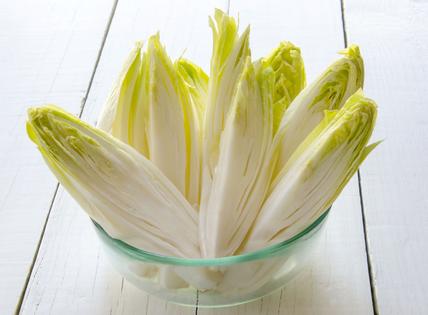Environmental Nutrition: Dive into endive
Endive is a relative newcomer to the leafy greens family, though it's grown from the root of chicory, one of the oldest known plants. A happy accident in 1830, a farmer in Belgium stored chicory roots in his cellar and left them several months while he was away. He returned to discover the chicory roots had sprouted small white leaves that were crisp and tasty. The rest is history. Endive came to Belgian markets in 1846 and garnered such a following that when introduced to Paris in 1872, it was known as "white gold." Grown worldwide today, endive is a nutrition powerhouse in a fancy package for any occasion.
The facts
Though all endive are types of chicory, there are two main types derived from the root of chicory: curly endive (Cichorium endivia var crispum), also called frisee, and broad-leaved endive (Cichorium endivia var latifolia), commonly known as escarole. This type of endive is grown twice -- once as chicory -- and a second time when the chicory roots are induced to grow in cold storage. Belgian endive (Cichorium intybus), along with raddichio and sugarloaf, are different species, grown as chicory crops for their leaves, which are commonly used in salads. Endive is a healthy, low-calorie source of vitamins and minerals, most notably vitamin K, which supports strong bones.
The findings
Endive is rich in the flavonoid kaempferol, known for its antioxidant, anti-inflammatory, and anticancer effects. These effects have been demonstrated in many disease models, including diabetes, asthma and cancer (European Journal of Medicinal Chemistry, 2014). Endive is also an excellent source of vitamin K, which has been shown to reduce bone fractures and cancer in clinical trials (Open Heart, 2015).
The finer points
Endive is grown year round. When buying, choose leafy heads with crisp leaves and no bruises or brown spots. Belgian endive is best when pale in color, so choose heads not exposed to light. To prepare, separate leaves or slice the entire head. Endive leaves make a beautiful cracker stand-in for carrying dips, cheese or another filling. It dresses up a salad with unexpected shape and flavor, and endive is a perfect addition chopped into soups, sauteed as a green, stirred into rice or other wholegrain side dishes, or brushed with olive oil and vinegar and tossed on the grill!
Notable Nutrients: Endive
1 cup (50 g), raw
Calories: 9
Vitamin A: 542 IU (22 percent DV)
Vitamin K: 115 mcg (144 percent DV)
Folate: 71 mcg (18 percent DV)
Manganese: 0.2 mg (10 percent)
Note: g=gram, IU=international units, mg=milligram, mcg=microgram,
DV=Daily Value, based on 2,000 calories/day
Endive with Mango Salsa Recipe
Makes 25 appetizer servings
Recipe adapted courtesy Melissa's Produce
2 large mangos, peeled, cored, finely diced
1 red onion, finely diced
1 bell pepper, finely diced
3 tablespoons lime juice
2/3 cup cilantro, chopped
Salt and pepper (to taste)
6 ounces endive bottoms, trimmed, leaves separated
1. In a bowl, gently combine all of the ingredients, except for the endive, to make a salsa.
2. Place a small amount of the salsa at the bottom end of the endive, and place on a platter as an appetizer.
Nutrition Information Per Serving: 15 calories, 0 grams (g) fat, 4 g carbohydrate 0 g protein,
0 g dietary fiber, 1 milligrams sodium, 3 g sugar.
(Environmental Nutrition is the award-winning independent newsletter written by nutrition experts dedicated to providing readers up-to-date, accurate information about health and nutrition in clear, concise English. For more information, visit www.environmentalnutrition.com.)







